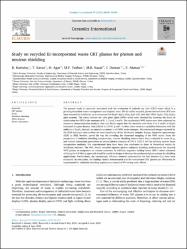| dc.contributor.author | Kurtuluş, R | |
| dc.contributor.author | Kavas, T | |
| dc.contributor.author | Ağar, Osman | |
| dc.contributor.author | Turhan, Mehmet Fatih | |
| dc.contributor.author | Kaçal, Mustafa Recep | |
| dc.contributor.author | Dursun, İnan | |
| dc.contributor.author | Akman, Ferdi | |
| dc.date.accessioned | 2022-05-25T07:39:41Z | |
| dc.date.available | 2022-05-25T07:39:41Z | |
| dc.date.issued | 15.09.2021 | en_US |
| dc.identifier.citation | Kurtuluş, R., Kavas, T., Agar, O., Turhan, M. F., Kaçal, M. R., Dursun, I., & Akman, F. (2021). Study on recycled Er-incorporated waste CRT glasses for photon and neutron shielding. Ceramics International, 47(18), 26335-26349. | en_US |
| dc.identifier.issn | 1873-3956 | |
| dc.identifier.uri | https://doi.org/10.1016/j.ceramint.2021.06.044 | |
| dc.identifier.uri | https://hdl.handle.net/20.500.12933/1077 | |
| dc.description.abstract | The present study is extremely associated with the evaluation of cathode ray tube (CRT) waste which is a growing hazardous waste management and disposal issue. The Er-added recycled glasses derived from CRT have been successfully fabricated as a component for Na2O–Al2O3–SiO2–K2O–CaO–SrO–BaO–PbO–Fe2O3–TiO2–Er2O3 glass systems. The waste cathode ray tube panel glass (WPG) series were obtained by inserting the Er2O3 in substitution for CRT in the amounts of 0, 1, 3 and 5 mol%. The synthesized WPG series were then subjected to numerous characterization analysis. One can firmly report that the insertion ratio from 0 to 5 mol% in Er2O3 increased the glass density from 2.9216 to 2.9763 g/cm3. Further, there exists no crystalline formation with the addition of Er2O3, instead, an amorphous nature in all WPG series emerges. Microstructural images captured by the SEM technique also confirm the non-crystallinity of the fabricated samples. Energy dispersive spectroscopy (EDS) in SEM, besides, paved the way for revealing the elemental mapping of the WPG series. From the perspective of radiation shielding competencies, nuclear shielding features have been evaluated in terms of μm and related attenuation parameters at several photon energies of 276.4–1332.5 keV by utilizing narrow beam transmission methods. The experimental data have been also confirmed to those of theoretical results by WinXCom software. The HVL results revealed superior photon radiation shielding performances for recycled WPG glasses in comparison to various concretes. In addition, exposure buildup factor (EBF) values estimated utilizing the G-P fitting approach would be useful to design or develop the synthesized glass systems for shielding applications. Furthermore, the macroscopic effective removal cross-sections for fast neutron (ΣR) have been estimated. In conclusion, the findings clearly demonstrated that Er-incorporated CRT glasses can effectively be implemented in radiation shielding applications instead of Pb having toxic effects. | en_US |
| dc.language.iso | eng | en_US |
| dc.publisher | Elsevier | en_US |
| dc.relation.isversionof | 10.1016/j.ceramint.2021.06.044 | en_US |
| dc.rights | info:eu-repo/semantics/embargoedAccess | en_US |
| dc.subject | CRT glasses | en_US |
| dc.subject | Er2O3 | en_US |
| dc.subject | Radiation shielding | en_US |
| dc.subject | HPGe detector | en_US |
| dc.subject | Waste valorization | en_US |
| dc.title | Study on recycled Er-incorporated waste CRT glasses for photon and neutron shielding | en_US |
| dc.type | article | en_US |
| dc.authorid | 0000-0002-0676-9481 | en_US |
| dc.department | AFSÜ, Atatürk Sağlık Hizmetleri Meslek Yüksekokulu, Tıbbi Görüntüleme Teknikleri Bölümü | en_US |
| dc.contributor.institutionauthor | Turhan, Mehmet Fatih | |
| dc.identifier.volume | 47 | en_US |
| dc.identifier.issue | 18 | en_US |
| dc.identifier.startpage | 26335 | en_US |
| dc.identifier.endpage | 26349 | en_US |
| dc.relation.journal | Ceramics International | en_US |
| dc.relation.publicationcategory | Makale - Uluslararası Hakemli Dergi - Kurum Öğretim Elemanı | en_US |
















